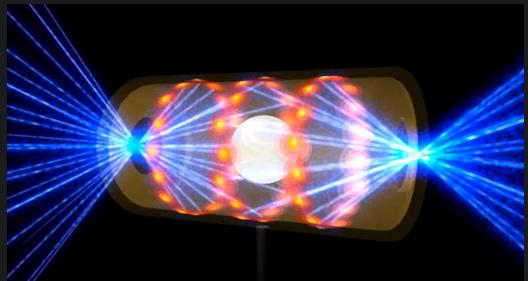博文
实验室在核聚变发电的漫长道路上取得了里程碑式的成就
 精选
精选
||
实验室在核聚变发电的漫长道路上取得了里程碑式的成就
诸平

Fig.1 This illustration provided by the National Ignition Facility at the Lawrence Livermore National Laboratory depicts a target pellet inside a hohlraum capsule with laser beams entering through openings on either end. The beams compress and heat the target to the necessary conditions for nuclear fusion to occur. Credit: Lawrence Livermore National Laboratory

Fig. 2 This image provided by the National Ignition Facility at the Lawrence Livermore National Laboratory shows the NIF Target Bay in Livermore, Calif. The system uses 192 laser beams converging at the center of this giant sphere to make a tiny hydrogen fuel pellet implode. Credit: Damien Jemison/Lawrence Livermore National Laboratory via AP
据物理学家组织网(phys.org)2022年1月26日报道,美国 劳伦斯·利弗莫尔国家实验室(Lawrence Livermore National Laboratory)的物理学家,用192束激光,温度比太阳中心高出三倍以上,科学家们至少在几分之一秒的时间里,在通向几乎无污染的核聚变能源的漫长道路上取得了关键的里程碑式的成就(Hot stuff: Lab hits milestone on long road to fusion power)。
位于加州劳伦斯·利弗莫尔国家实验室的国家点火装置(National Ignition Facility at the Lawrence Livermore National Lab in California)的研究人员能够激发一种聚变反应,这种反应能够持续很短的时间,这是一个重大的成就,因为聚变需要如此高的温度和压力,很容易就会熄灭。
最终目标是像太阳产生热量一样发电,这还需要数年的时间。这个目标是将挤压氢原子,使它们相互结合,形成氦(2H+3H→4He+),从而释放出大量的能量。一个由100多名科学家组成的团队在2022年1月26日的《自然》(Nature)杂志网站上发表了四项实验的结果,这些实验实现了所谓的燃烧等离子体——A. B. Zylstra, O. A. Hurricane, D. A. Callahan, A. L. Kritcher, J. E. Ralph, H. F. Robey, J. S. Ross, C. V. Young, K. L. Baker, D. T. Casey, T. Döppner, L. Divol, M. Hohenberger, S. Le Pape, A. Pak, P. K. Patel, R. Tommasini, S. J. Ali, P. A. Amendt, L. J. Atherton, B. Bachmann, D. Bailey, L. R. Benedetti, L. Berzak Hopkins, R. Betti, S. D. Bhandarkar, J. Biener, R. M. Bionta, N. W. Birge, E. J. Bond, D. K. Bradley, T. Braun, T. M. Briggs, M. W. Bruhn, P. M. Celliers, B. Chang, T. Chapman, H. Chen, C. Choate, A. R. Christopherson, D. S. Clark, J. W. Crippen, E. L. Dewald, T. R. Dittrich, M. J. Edwards, W. A. Farmer, J. E. Field, D. Fittinghoff, J. Frenje, J. Gaffney, M. Gatu Johnson, S. H. Glenzer, G. P. Grim, S. Haan, K. D. Hahn, G. N. Hall, B. A. Hammel, J. Harte, E. Hartouni, J. E. Heebner, V. J. Hernandez, H. Herrmann, M. C. Herrmann, D. E. Hinkel, D. D. Ho, J. P. Holder, W. W. Hsing, H. Huang, K. D. Humbird, N. Izumi, L. C. Jarrott, J. Jeet, O. Jones, G. D. Kerbel, S. M. Kerr, S. F. Khan, J. Kilkenny, Y. Kim, H. Geppert Kleinrath, V. Geppert Kleinrath, C. Kong, J. M. Koning, J. J. Kroll, M. K. G. Kruse, B. Kustowski, O. L. Landen, S. Langer, D. Larson, N. C. Lemos, J. D. Lindl, T. Ma, M. J. MacDonald, B. J. MacGowan, A. J. Mackinnon, S. A. MacLaren, A. G. MacPhee, M. M. Marinak, D. A. Mariscal, E. V. Marley, L. Masse, K. Meaney, N. B. Meezan, P. A. Michel, M. Millot, J. L. Milovich, J. D. Moody, A. S. Moore, J. W. Morton, T. Murphy, K. Newman, J.-M. G. Di Nicola, A. Nikroo, R. Nora, M. V. Patel, L. J. Pelz, J. L. Peterson, Y. Ping, B. B. Pollock, M. Ratledge, N. G. Rice, H. Rinderknecht, M. Rosen, M. S. Rubery, J. D. Salmonson, J. Sater, S. Schiaffino, D. J. Schlossberg, M. B. Schneider, C. R. Schroeder, H. A. Scott, S. M. Sepke, K. Sequoia, M. W. Sherlock, S. Shin, V. A. Smalyuk, B. K. Spears, P. T. Springer, M. Stadermann, S. Stoupin, D. J. Strozzi, L. J. Suter, C. A. Thomas, R. P. J. Town, E. R. Tubman, P. L. Volegov, C. R. Weber, K. Widmann, C. Wild, C. H. Wilde, B. M. Van Wonterghem, D. T. Woods, B. N. Woodworth, M. Yamaguchi, S. T. Yang, G. B. Zimmerman. Burning plasma achieved in inertial fusion. Nature, Published: 26 January 2022. Volume 601, pages 542–548. DOI: 10.1038/s41586-021-04281-w. https://www.nature.com/articles/s41586-021-04281-w.
有了这些结果,再加上2021年8月公布的后续实验的初步结果,科学家们说,他们即将迎来一个更大的进步:点火。此时,燃料可以继续自己“燃烧”,并产生比引发最初反应所需的更多的能量。
该研究的主要作者、劳伦斯·利弗莫尔国家实验室的实验物理学家亚历克斯·齐尔斯特拉(Alex Zylstra)说:“我们离下一步非常近。”
核聚变将水分子中的两种氢结合在一起。当它们融合时,“少量(毫克)的燃料产生巨大的能量,而且它也非常‘干净’,因为它不会产生放射性废物,”卡洛琳·库兰兹(Carolyn Kuranz)说,她是密歇根大学(University of Michigan)的实验等离子体物理学家,没有参与这项研究。她说:“这基本上是一种可以在任何地方使用的无限清洁能源。”
几十年来,世界各地的研究人员一直在研究这项技术,尝试不同的方法。35个国家正在法国南部合作一个名为国际热核实验反应堆(International Thermonuclear Experimental Reactor)的项目,该项目使用巨大的磁铁来控制过热的等离子体。预计将于2026年开始运营。
普林斯顿等离子体物理实验室(Princeton Plasma Physics Laboratory)主任史蒂文·考利(Steven Cowley)说,早前在美国和英国进行的实验成功地实现了原子核聚变,但没有实现自热。史蒂文·考利没有参与这项研究。
上述图2(Fig. 2)由劳伦斯利弗莫尔国家实验室的国家点火装置提供的图像显示了位于加利福尼亚州利弗莫尔的NIF目标湾。该系统使用192束激光束汇聚在这个巨大球体的中心,使一个微小的氢燃料球团发生内爆。但是现在还不要指望核聚变。
该研究的合著者、劳伦斯·利弗莫尔聚变项目的首席科学家奥马尔·哈利肯(Omar Hurricane)说:“这个结果在科学上对我们来说是非常令人兴奋的,但我们距离有用的能源还有很长的路要走。也许几十年。”
这个取自电影《星际迷航》(Star Trek)的实验室已经花了几年时间,其中一部电影将实验室用作企业号引擎室的背景视觉效果,但多次尝试都失败了。有一项调整起到了作用:研究人员将燃料舱放大了约10%。现在它达到了BB的大小。
这个胶囊装在一个微小的金金属罐里,研究人员将192束激光对准这个金属罐。他们将其加热到大约1亿度,在胶囊内部产生的压力比太阳中心内部的压力高出50%。亚历克斯·齐尔斯特拉说,这些实验产生的等离子体燃烧只持续了万亿分之一秒,但这足以被认为是成功的。
亚历克斯·齐尔斯特拉说,总的来说,《自然》(Nature)杂志研究中在2020年11月和2021年2月进行的四项实验产生了多达0.17兆焦耳的能量,这远远超过了之前的尝试,但仍然不到启动过程所用能量的十分之一。1兆焦耳的能量足以将一加仑水(约3.8 L)加热38 ℃。
根据一份政府新闻稿,2021年晚些时候进行的实验的初步结果,将能量输出推至130万焦耳,持续时间为100万亿分之一秒。该实验仍在接受其他科学家的审查。但即便如此,也还没有达到收支平衡所需的190万焦耳。
普林斯顿大学的史蒂文·考利说:“核聚变的主要问题是它很难。否则,这可能是实现能源可持续、丰富、安全和环境影响最小化的完美方式。”
上述介绍,仅供参考。欲了解更多信息,敬请注意浏览原文或者相关报道。
Researchers at the brink of fusion ignition at National Ignition Facility
Obtaining a burning plasma is a critical step towards self-sustaining fusion energy1. A burning plasma is one in which the fusion reactions themselves are the primary source of heating in the plasma, which is necessary to sustain and propagate the burn, enabling high energy gain. After decades of fusion research, here we achieve a burning-plasma state in the laboratory. These experiments were conducted at the US National Ignition Facility, a laser facility delivering up to 1.9 megajoules of energy in pulses with peak powers up to 500 terawatts. We use the lasers to generate X-rays in a radiation cavity to indirectly drive a fuel-containing capsule via the X-ray ablation pressure, which results in the implosion process compressing and heating the fuel via mechanical work. The burning-plasma state was created using a strategy to increase the spatial scale of the capsule2,3 through two different implosion concepts4,5,6,7. These experiments show fusion self-heating in excess of the mechanical work injected into the implosions, satisfying several burning-plasma metrics3,8. Additionally, we describe a subset of experiments that appear to have crossed the static self-heating boundary, where fusion heating surpasses the energy losses from radiation and conduction. These results provide an opportunity to study α-particle-dominated plasmas and burning-plasma physics in the laboratory.
https://m.sciencenet.cn/blog-212210-1323665.html
上一篇:绍兴文理学院2022年发表论文超过110篇
下一篇:首次发现了人类突变起源的长期方向性证据,挑战新达尔文主义